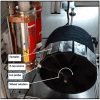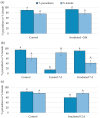Improving the Efficiency and Safety of Sentinel Stink Bug Eggs Using X-rays
- PMID: 39452343
- PMCID: PMC11508251
- DOI: 10.3390/insects15100767
Improving the Efficiency and Safety of Sentinel Stink Bug Eggs Using X-rays
Abstract
Sentinel eggs used to monitor field parasitism of stink bug pests (Hemiptera: Pentatomidae) can only be deployed for a few days to avoid releasing the pest in the monitored area. Using sterile eggs removes the risk of accidental pest introduction and extends deployment time. Freezing the eggs before deployment is one common method of sterilizing sentinel eggs. However, some egg parasitoid species have low or no parasitism on frozen eggs. In this study, X-ray irradiation was used to sterilize Bagrada hilaris sentinel eggs intended for monitoring parasitism by Gryon aetherium (Hymenoptera: Scelionidae), the most promising biological control candidate. In this case, freezing sentinel eggs is not recommended because G. aetherium has low levels of parasitism on frozen eggs. Doses as low as 10 Gy induced 100% sterility. Irradiated eggs successfully sustained the development of G. aetherium and Ooencyrtus californicus (Hymenoptera: Encyrtidae), another egg parasitoid attacking B. hilaris, and parasitism levels were comparable to that of fresh eggs up to seven days old. In addition, G. aetherium showed no preference for fresh non-irradiated eggs over seven-day-old irradiated eggs. Our results indicate that X-ray irradiation is a suitable alternative to produce safe and reliable sentinel eggs to monitor the egg parasitism of B. hilaris and possibly other species.
Keywords: biological control; egg parasitoids; egg sterilization; field monitoring; irradiation; pentatomids.
Conflict of interest statement
The authors declare no conflicts of interest.
Figures






References
-
- Heimpel G.E., Mills N.J. Biological Control. Cambridge University Press; Cambridge, UK: 2017.
-
- Van Lenteren J.C. Implementation of biological control. Am. J. Altern. Agric. 1988;3:102–109. doi: 10.1017/S0889189300002265. - DOI
-
- Mahmood R., Jones W.A., Bajwa B.E., Rashid K. Egg parasitoids from Pakistan as possible classical biological control agents of the invasive pest Bagrada hilaris (Heteroptera: Pentatomidae) J. Entomol. Sci. 2015;50:147–149.
-
- Conti E., Avila G., Barratt B., Cingolani F., Colazza S., Guarino S., Hoelmer K., Laumann R.A., Maistrello L., Martel G. Biological control of invasive stink bugs: Review of global state and future prospects. Entomol. Exp. Appl. 2021;169:28–51. doi: 10.1111/eea.12967. - DOI
Grants and funding
LinkOut - more resources
Full Text Sources
Medical

